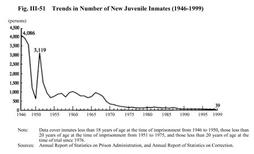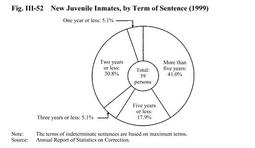| Previous Next Index Image Index Year Selection | |
|
|
2 Conditions of detention and characteristics of juvenile inmates Trends in the number of new juvenile inmates(that is, juvenile inmates newly imprisoned following final adjudications, including those aged20or over at the time of imprisonment;the same applies throughout this section)since 1946are shown in Fig. III-51.
Fig. III-51 Trends in Number of New Juvenile Inmates(1946-1999) The number of juvenile inmates, standing at4,086in1946,dropped to622in1950,only to rebound to over3,000in1951as the age limit for the application of the Juvenile Law was revised upward from less than18to less than20. The number has since shown a generally downward trend, with some fluctuations.New juvenile inmates in1999numbered39(down from44in the previous year), all of them males. Of the new juvenile inmates,36(down from37)were less than20years of age at the time of imprisonment. As of December31,1999,31inmates(up from20)were less than20years of age. Fig. III-52 shows the ratios of new juvenile inmates in1999,by term of sentence. Of these,37inmates received indeterminate sentences. By type of penalty, all of the39inmates were sentenced to imprisonment with labor(compared to43imprisoned with labor and1imprisoned without labor in the previous year). By type of offense,37committed penal code offenses, while the other2were imprisoned for special law offenses. The most common penal code offense was professional negligence causing death or bodily injury(8inmates). This was followed by robbery resulting in homicide or bodily injury(7), larceny and rape resulting in homicide or bodily injury(5each), homicide(4), bodily injury resulting in homicide(3), and rape or rape resulting in homicide in the course of robbery(2). Fig. III-52 New Juvenile Inmates, by Term of Sentence(1999) |

